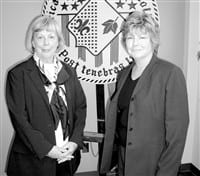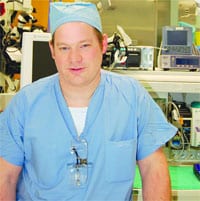Healthy Resolutions Noble Hospital Program Helps People Change Their Lifestyles For The Better
Donna Russell Sposito considers herself normal.
“That means I eat more of the wrong kinds of food than the right kinds of foods,” she said, “and it means I’m not as active as I could be or should be.” It also makes her a prime candidate for a new initiative launched at the start of the year by Noble Hospital in Westfield. Called Healthy Resolutions, the 13-week program helps individuals make lifestyle changes by stressing the importance of diet and exercise.
The 200 or so individuals who signed up for what is expected to be the first of many sessions of the program have spent the past two months learning how to read nutrition labels, put together a sensible diet, and incorporate increasing amounts of exercise into their daily routines.
And if there is a word that defines the program, it is reasonable, said Russell Sposito, 46, who told The Healthcare News that there are no fads involved with this initiative, or expensive pieces of equipment to buy, or unrealistic expectations placed on participants.
“It’s all common-sense stuff,” she said, adding that participants are encouraged to keep things in perspective and maintain a sense of humor. “They tell you that you’re going to have bad days and you’re going to have slips, but that’s also part of being normal, and when they happen, it’s not the end of the world.”
Diane Chambers, assistant director of marketing at Noble, said the program is doing what it was designed to do — prompt people to pay attention to matters involving health and fitness and to take control of their bodies.
“We stress that people need to focus on diet and nutrition not for 13 weeks, but for the rest of their lives,” she said.
Weighty Issues
When asked about the genesis of Healthy Resolutions, Chambers started with a reference to Noble’s annual road race in April. Now in its 20th year, the race has become a spring tradition in Westfield, and Chambers, like other event organizers, had been looking for ways to draw more entrants.
The thinking was that if the hospital could get more members of the community thinking about health and fitness, then more would choose to run or walk the three-mile route.
But the real inspiration for the program was the seemingly endless run of news stories about the country’s worsening obesity problem, said Chambers. She told The Healthcare News that when physicians talk about health issues such as heart disease, stroke, Type II diabetes, breathing problems, and even psychological disorders — and how to prevent them — the common denominators are diet, exercise, and the resulting weight reduction.
“Obesity is a big problem in this country, and I think people are starting to understand that it can lead to a number of health problems down the road,” said Chambers, noting quickly that Noble’s program is not only for those who need to lose weight, but also those who just want to be healthier.
Program administrators targeted the program for Jan. 1, when many people are focused on resolutions and new starts, said Chambers, noting that coordinators were expecting maybe a few dozen area residents to participate, and instead saw a few hundred.
Those numbers offer ample evidence of the health problems facing Americans, and an acknowledgement on the part of many people that they need to do something about their health and well-being, said Karen Johnson, chief clinical dietitian at Noble and one of the program’s coordinators.
“It’s amazing how many people have chosen to participate,” she said. “I think it’s a strong indication that many people realize that they have to change their lifestyles.”
Participants got started by having measurements taken of their body mass index (BMI) and body fat — they’ll be measured again when the program ends in April — and the numbers recorded reflect what’s happening across the country.
BMI basically assigns a number based on a formula that incorporates height and weight. Calculating it is simple: multiply one’s weight in pounds by 703, then divide by height in inches, and divide by height in inches again. A number between 18.5 and 24.9 falls within the normal range, while a number of 25 or above indicates someone is overweight, and 30 and above signals obesity.
The average for the 200 or so individuals who turned out for measurements was right on the obesity line — 30.9, said Chambers, adding that the average percentage of body fat — 35.4{06cf2b9696b159f874511d23dbc893eb1ac83014175ed30550cfff22781411e5} — was equally unimpressive.
Taking Suggestions to Heart
To go to work on those numbers, participants were asked to focus on diet and exercise simultaneously. In groups of 20, they have been taken to Big Y and given instruction on how to read nutrition labels and buy healthier foods.
Russell Sposito said it was an eye-opening experience.
“I think everyone knows to look at calories and fat content,” she explained. “But there’s much more to it; we were taught how to look for traps — foods that might have the word ‘healthy’ in their label somewhere, but really aren’t.”
Jennifer Giffune, RD, LDN, the outpatient diabetes dietitian at Noble and director of the hospital’s Women’s Heart Health program, conducts the tours. She told The Healthcare News that the point of the exercise is not to point out which box of cereal might be best for people looking to lower cholesterol, but to educate individuals on how to make the right choices.
Manufacturers can change the way they make foods in a heartbeat,” she explained. “They don’t have to tell us, and it may not be in a positive direction for our health; they may find that if they put more sugar in something or more salt or more fat, people will like it better, and they’ll buy it.
“You have to be able to know how to assess things today, tomorrow, and next year,” she continued, “and not merely have me tell you what the best foods are to eat.”
The supermarket tours go down every aisle, said Giffune, adding that much time is usually spent in the bread area, the cereal aisle, the produce section, and the ice cream freezer.
Emphasis is put on fat and calories, naturally, she said, but also general health, and thus a focus on sodium, carbohydrates, calcium, and other lines on the label. When the tour stops at the peanut butter aisle, for example, participants are told to beware low-fat offerings, because the fat in peanut butter is actually heart-healthy.
Russell Sposito said the focus on nutrition has prompted her to change some habits and try new, healthier foods. She’s cut back on cookies and juices, and even added veggie-burgers to her routine. “Before, I wouldn’t have touched one of those with a 10-foot pole,” she said. “But when you look at the label, you say, ‘why not?’ And they’re actually not bad.”
As for the exercise side of the equation, each participant is given an exercise diary that will increase physical activity from 15 minutes of exercise three days a week to 48 minutes four days a week, said Chambers.
The goal with exercise is the same as it is for nutrition — development of healthy habits, she said, adding that the emphasis is on gradual modifications, not fad diets or crash exercise programs, to achieve long-term lifestyle changes.
“What we’re doing is putting an individual’s health in their own hands,” she said. “We’re telling them that they have to take responsibility for their own health.”
And as the first session of the program winds down, organizers are thinking about when and how to conduct the next session, and also about how to keep those already involved motivated and monitored.
Giffune, who has been conducting supermarket tours for groups and individuals for 15 years, said Healthy Resolutions is unique in that it brings together large numbers of people who are interested in change. Although organizers hope that participants will stick with their new routines long after their April 12 measurements, it will be easy for many to fall back into old habits, she explained.
“We’re looking at things we can do to keep these people motivated, “ she said, adding that the program is certainly worthwhile because it gets the community focused on health. “Any change is better than no change at all.”
Good Fit
Russell Sposito says she’s not expecting anything dramatic when she goes for the final measurements in April. Her BMI might show slight improvement, and her percentage of body fat may drop slightly, but there probably won’t be too much to celebrate.
More important than those numbers, she said, is the positive attitude she has, the knowledge she’s gained, and the momentum that will eventually make those numbers better.
“This is not a diet; it’s a lifestyle change,” she said. “And change is a process … it takes time. I’m feeling better about myself, and that’s what’s important.”



Comments are closed.